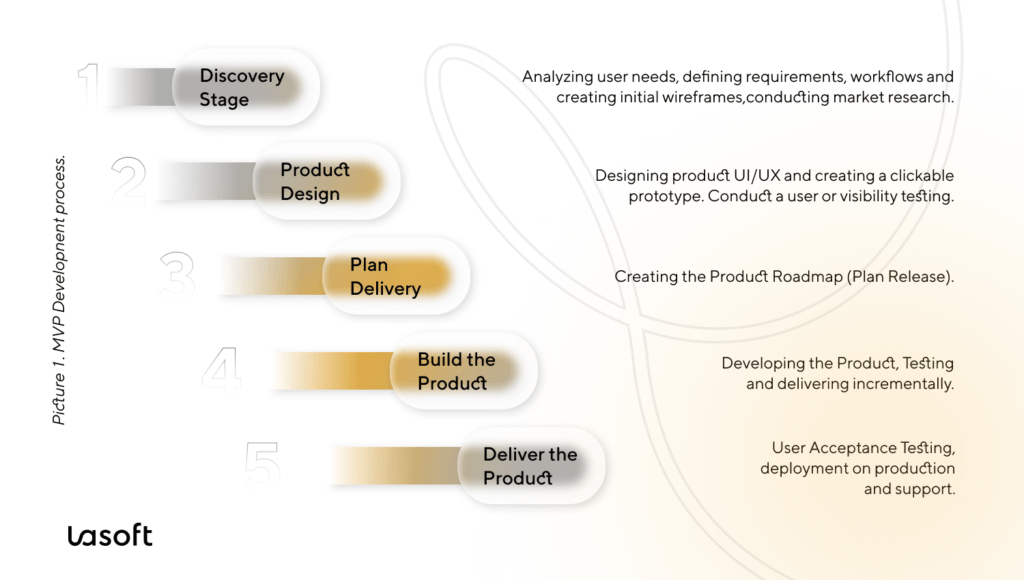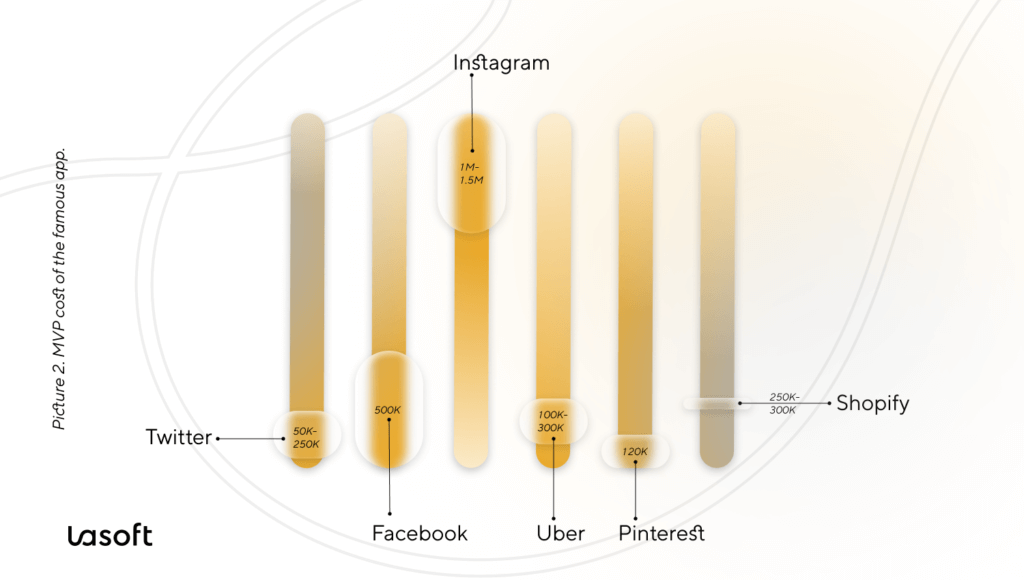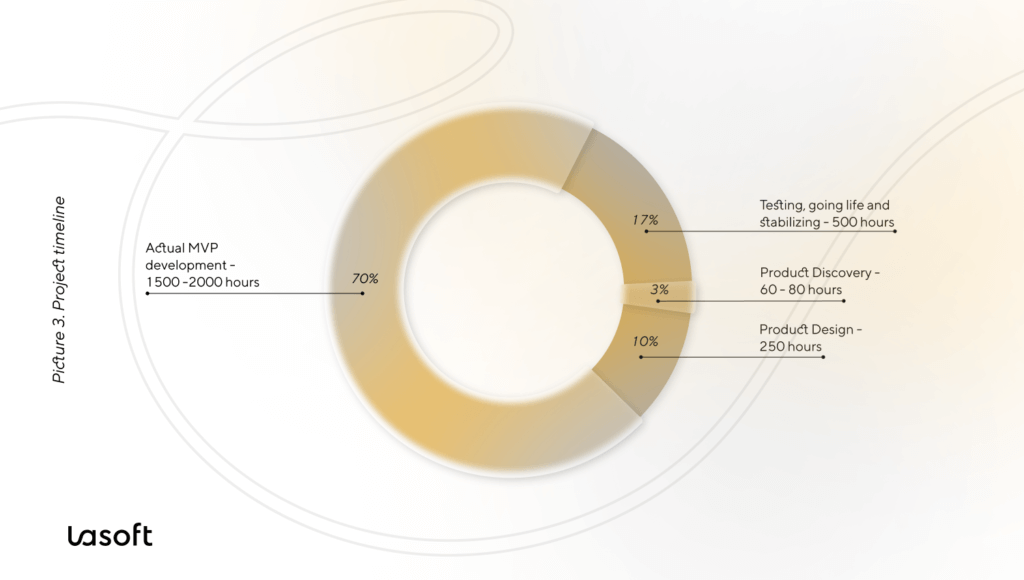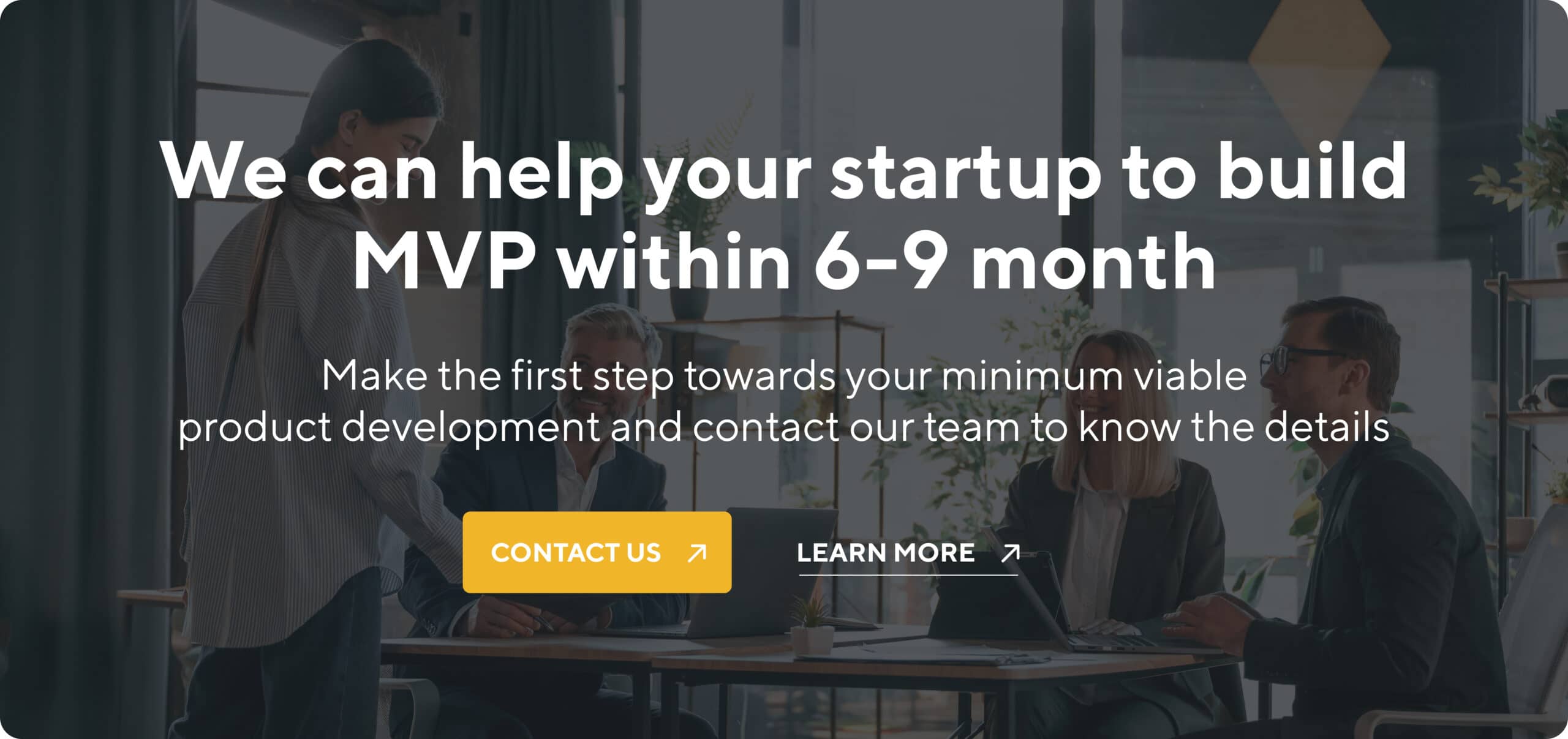Starting your digital business with an MVP (Minimum Viable Product) is a reasonable solution if you want to avoid risks and test your idea before developing a fully-fledged product. It all translates into saving your money and time and maximizes the chances for your project to succeed. Given that 90% of startups fail, building a Minimum Viable Product cost efficiently is a must to make a proof for your online businesses.
However, MVP building is also a financial investment. So how much does it cost to create an MVP? You have probably googled Minimum Viable Product cost and feel confused about the huge gap between the minimum of around $15,000 and the maximum of $100,000 and more. This difference is quite average since many factors affect the cost of MVP development. Let’s discuss them all in detail.
Fully-functional MVP Process Explained
MVP software development is not just about the Minimum Viable Product building process. Before the Development process starts additional steps are completed: Discovery Stage, creating Product UI/UX, Planning Product Delivery. So, in order to make an MVP process maximally effective we need to complete all required steps to have a clear and agreed understanding of the Product.

Picture 1. MVP Development process.
Below is a more detailed overview of the MVP development process.
Discovery Phase
The MVP development process starts with market research to ensure that the future product will be able to meet the target audience’s needs. Also a marketing team should analyze your competition to determine your product’s chances of surviving in the market.
In parallel, business analysts will conduct a series of interviews with a founder to get insights that will help to design, select and prioritize features for your future MVP.
Depending on your needs on this stage you will work with Business Analyst, Product Designer, System Architect and Marketing Manager. Usually it takes between 60-150 hours, which is around 3% of your total MVP budget. We always recommend our clients to go through the Discovery stage, as it helps to clarify requirements and reduces potential project and business risks substantially.
We can make a good parallel with building a house. Discovery is similar to discovering your future land and making the architecture and design of your home. Building MVP is not less complex than building a house, but while building a house without prior architecture sounds ridiculous to everyone, building MVP without prior discovery sounds okay, and this is the wrong impression.
Product Design
I believe that Discovery and Product Design Phases are two the most important stages of your MVP, that lay down the foundation of your future success. It is advisable not to neglect them.
Idea Validation
Important step in Minimum Viable Product software development is to get a proof whether the product can deliver value to its users. We use Value Proposition Canvas that helps to understand complex Product idea, define the Product and associated services, and determine potential Product usage scenarios. Using this tool we can define customers, their pains and gains, and find ways how we can help end-users to achieve their goals using the Product.
Product Design and Prototype
As soon as the project stakeholders approve the idea behind the project, the MVP team starts working on the MVP’s design, creating a smooth interface and rewarding user experience. The finalized product design alongside the prototype is an MVP itself that can be used to communicate your idea better to your users, investors and friends. Prototype is a simple, lightweight visualization of your solution that encompasses its look, flow, and user interaction to test ideas before they are fully developed. The LaSoft Product Design Team develops a prototype within 3-4 weeks without a single line of code.
Having a good prototype is enough to test and share your idea and collect feedback. Yes, you will not make money if you have a prototype only, but testing is a good reasonable step in your MVP journey.
Prototype Testing*
Prototype testing is a process of testing crucial flows and features of the project that were created on the design stage. It displays how the system will work on the front-end side only and allows potential users to work with it before the development process begins.
In this case we can receive early feedback from users and make changes before the development. So, this may help to reduce project budget, because making changes during the design stage is less costly.
This step is very important for MVP projects whose ideas are not well-formed yet. It helps to test Product usage scenarios before the Product is developed and it can help improve the idea on the earlier stages.
There are two options of conducting Prototype Testing:
Option 1: Product Designer creates testing scenarios, provides Client with Prototype Testing manuals and articles, and Client conducts his/her own Prototype Testing and collects feedback from potential users.
Option 2: Product Designer creates testing scenarios, Client provides a list of potential users, Product Designer conducts Prototype Testing meetings with those users. That is when the feedback is collected.
After Prototype Testing meetings are conducted, all the feedback from users are collected and processed. Based on feedback results there might be changes in the project functionality.
Planning
During this stage, we priorityze the MVP scope and create a Project Timeline that displays what functionality will be created whithin a specific period of time, and what is an expected delivery date and a planned budget for its development.
Actual MVP Development
Finally, MVP developers write code to transform the design into a functional product. This stage is the most expensive and will suck close to 70% of the entire MVP development budget. The entire team of software developers will be working for 6-9 months to make your system live.
Although testing an MVP is often overlooked, it’s crucial to run tests to make sure that the MVP is ready to go live. Here’s why: if the MVP isn’t tested for bugs, they can interfere with users adequately assessing the product and giving constructive feedback on the UI/UX.
MVP Launch and Improvement
Upon the MVP launch, the team collects feedback from the first users and makes continuous updates based on their feedback. There can be several iterations until you achieve the desired result.
You might need only one or a few of the mentioned services, which can significantly reduce the total cost. For instance, you may already have market research done or need just a prototype to be built — there are various cases that call for an individualized approach.
Critical Factors Affecting the MVP Cost
To help you properly allocate your MVP budget, we’ve gathered the key factors that determine the MVP development cost.
Project Scope and Complexity
That might sound like a no-brainer, but this is a gentle reminder that the more complex your project is, the more you will need to pay. Two factors can explain the higher cost for a more sophisticated MVP.
First, if you’re going to develop an MVP for a more complex application, you’ll probably want to include more features in its basic functionality. Second, your unique project might require a dedicated team of experts to solve complex tasks.
To have a better idea of how the project complexity correlates with the cost of Minimum Viable Product development, here are some estimates based on famous apps:
- Twitter – around $50K to $250K
- Facebook – around $500K
- Uber – $1M to $1.5M
- Instagram – $100K to $300K
- Pinterest – around $120K
- Shopify – $250K to $300K

Picture 2. MVP cost of the famous app.
The complexity of the UX/UI Design
Typically, a simple design suffices to build a worthwhile MVP. However, app design might serve a decisive role in your niche, so it can be a wise solution to inject a more complicated design into your MVP, including 3D images, animations, or other custom elements. Consequently, a more complex design will push up the cost of the MVP development.
Platforms
Which platform do you want your MVP to run on? Web, iOS, or Android? Will it be a native or a cross-platform app? The platform for your MVP is another critical factor affecting the cost of MVP development.
Type of Contract and Scope Changes
The cost of building an MVP can largely vary depending on the type of contract you enter into. Basically, you have two options: paying for time and material or a fixed price.
The time and material contract means you only pay for what you get, namely the work measured in hours. This approach is more widespread due to its clear advantages.
To start with, it makes the MVP development more flexible — it allows you to implement changes, such as adding or removing specific features, even when the development started.
Next, it helps to keep MVP costs as low as possible since you pay only for what is done based on a previously agreed hourly rate.
On the other hand, you can choose a fixed-price contract based on rigid costs that are determined in advance and can’t be changed. Although this approach might help reduce the MVP cost and protect the budget from unpredicted changes, it’s not always so.
The thing is that fixed price contracts often encompass a 15-40% buffer against possible risks, which means high chances of overpaying.
Project Timeline
If you opt for a time and material contract, the cost of your MVP will grow with the number of hours needed to complete the project. Apparently, the more complex your project is, the more time your MVP development will take.
In addition, let’s remember that building an MVP is a lengthy process involving many activities beyond the actual development, each taking up a certain amount of time.
Here are some average estimations for your information:
- Product Discovery — 60-80 hours (3%)
- Product Design — 250 hours (10%)
- Actual MVP development — 1500-2000 hours (70%)
- Testing, going live and stabilizing — 500 hours (17%)

Picture 3. Project timeline.
Hourly Rate
Together with the project timeline, the hourly rate is the key factor feeding into the cost of MVP development. Hourly rates fluctuate dramatically across different regions, driving established businesses and startups to outsource their MVP development.
For instance, while the hourly rate in the USA and Western Europe averages about $150, you can expect to pay half of that if you hire a team from an East-European country such as Poland or Ukraine without compromising on quality.
Consider the Post-Launch MVP Costs
Also, remember that MVP expenses don’t end once the Minimum Viable Product is launched. You need to plan a budget for MVP marketing additionally. The marketing cost will depend upon the marketing approach you choose, such as social media promotions, sponsored search engine ads, or corporate events. Expect your MVP marketing cost to be around $10K.
Another thing to keep in mind is that your MVP will call for continuous maintenance and support in order to be competitive. This cost typically makes up 20% of the initial MVP budget.
Let’s Test Your Ambitious Project Idea through an MVP
How much does it cost to create a Minimum Viable Product? Numerous factors affecting the MVP cost make it impossible to give an exact response to this question. That is why it would be a reasonable solution to reach out to experts who can provide you with a more precise estimation based on their expertise.
At LaSoft, we’ll help you develop a cost-efficient application following the MVP software development approach, competently adapting the list of the basic features to your budget.

_____________________________________________________
* Optional – not every product needs testing…


